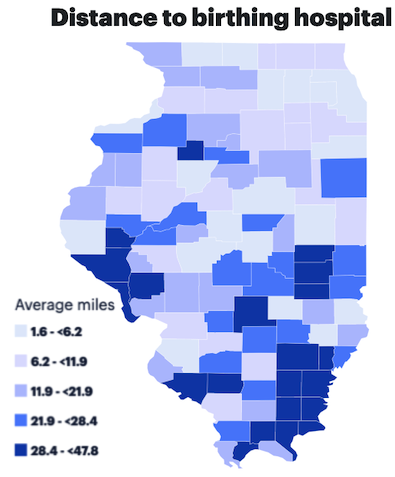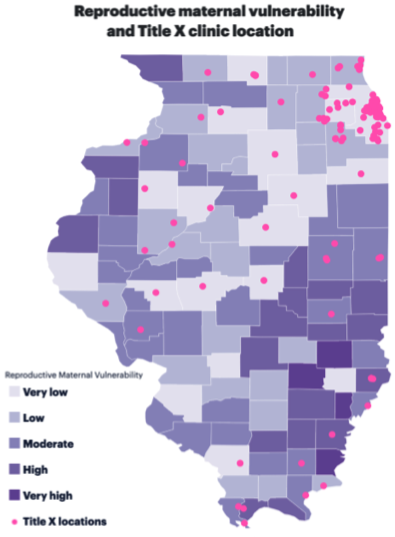


Latest Post | Last 10 Posts | Archives
Previous Post: The lost art of outreach
Next Post: DeSantis sides with Mary Miller, against Pritzker on new Illinois law
Posted in:
With over 3.5 million births in the United States annually, and rising rates of maternal mortality and morbidity, there is ample opportunity to improve maternal outcomes across the country. More than 2 million women of childbearing age live in maternity care deserts, areas without access to birthing facilities or maternity care providers. Access to maternity care is essential for preventing poor health outcomes and eliminating health disparities. This report expands on the 2022 Nowhere to Go: Maternity Care Deserts Across the U.S. report by taking a deeper dive into state level data and examining additional barriers that impact access to care. This data can be used to inform policies and practice recommendations in each state.
This report presents data on several important factors: levels of maternity care access and maternity care deserts by county; distance to birthing hospitals; availability of family planning services; community level factors associated with prenatal care usage as well as the burden and consequences of chronic health conditions across the state. While not an exhaustive list, each of these topics contribute to the complexity of maternity care access in each state. Working to improve access to maternity care by bringing awareness to maternity care deserts and other factors that limit access is one way in which March of Dimes strives to reduce preventable maternal mortality and morbidity for all pregnant people.
* You can click here to see an interactive national map. But let’s look at some of the Illinois-specific study findings…
* 4.6% of women had no birthing hospital within 30 minutes compared to 9.7% in the U.S.
* 13.7% of birthing people received inadequate prenatal care, less than the U.S. rate of 14.8%.
* 3.8% of babies were born to women who live in rural counties, while 1.8% of maternity care providers practice in rural counties in Illinois.
* In Illinois, women travel 6.8 miles and 12.3 minutes, on average, to their nearest birthing hospital. Overall, in the U.S. women travel 9.7 miles to their nearest birthing hospital.
* Women living in counties with the highest travel times (top 20 percent) could travel up to 47.8 miles and 59 minutes, on average, to reach their nearest birthing hospital.
* In rural areas across Illinois, 35.5% of women live over 30 minutes from a birthing hospital compared to 3.5% of women living in urban areas.
* Women living in maternity care deserts traveled 5.1 times farther than women living in areas with full access to maternity care in Illinois.
* There are 4 Title X [family planning] clinics per 100,000 women in Illinois compared to 5.3 per 100,000 in the U.S. overall.
* On average, people living in maternity care deserts in Illinois, travel 4 times farther to reach their nearest Title X clinic compared to people living in full access counties.
* In Illinois, the [pre-term birth] rate was 10.7 percent, compared to 10.5 percent in the U.S. overall in 2021.
* They also have county interactive maps, so click here to see those…



posted by Rich Miller
Tuesday, Aug 1, 23 @ 11:41 am
Sorry, comments are closed at this time.
Previous Post: The lost art of outreach
Next Post: DeSantis sides with Mary Miller, against Pritzker on new Illinois law
WordPress Mobile Edition available at alexking.org.
powered by WordPress.
Union County has full access while Willamson has moderate.
How? Heartland Regional shut down their OB/GYN clinic. They are a hospital in name only.
Comment by Flyin'Elvis'-Utah Chapter Tuesday, Aug 1, 23 @ 11:56 am
A woman needs to have care for all nine months so having access to a provider is very important. Not only that, infant mortality, like maternal mortality, is also very high in the United States.
Comment by Betty Draper’s cigarette Tuesday, Aug 1, 23 @ 12:08 pm
In Logan County, they’re down to one OB/GYN as of May
https://www.wglt.org/local-news/2023-05-17/a-rural-illinois-hospital-closed-its-labor-and-delivery-unit-a-month-later-a-baby-was-born-along-i-55
Comment by LincolnCoNative Tuesday, Aug 1, 23 @ 12:11 pm
All those south east counties go to Paducah Kentucky.
Comment by Hibbing Tuesday, Aug 1, 23 @ 12:48 pm
The distance to nearest birthing hospital does not look right for Coles county. It is listed as greater than 28.4 miles. The local (regional) hospital is located between Charleston and Mattoon. The physical distance from middle of Charleston to the hospital may be 6 miles or 7 minutes and closer for Mattoon.
Comment by no relation Tuesday, Aug 1, 23 @ 1:17 pm
Maybe counties with low levels of maternity care could partner with the State and Medicaid to deploy mobile health care vans or part time clinics for community health care which would include pre-natal visits, family planning, diabetes care and limited emergency care. Does the lack of facilities arise from liability issues, lack of funding, low population or all of these issues? They will never be profit centers but we can choose to subsidize public clinics to meet these needs.
Comment by froganon Tuesday, Aug 1, 23 @ 1:27 pm
Seems that the State of Illinois is doing more for abortion needs than birthing needs.
Comment by Blanche Tuesday, Aug 1, 23 @ 1:51 pm
“Seems that the State of Illinois is doing more for abortion needs than birthing needs.”
What’s that based on? A pregnant woman needs providers before during and after giving birth. Her infant willneed care too. That is going to take up more providers’ time than an abortion. Apples and oranges.
Comment by Betty Draper’s cigarette Tuesday, Aug 1, 23 @ 5:21 pm